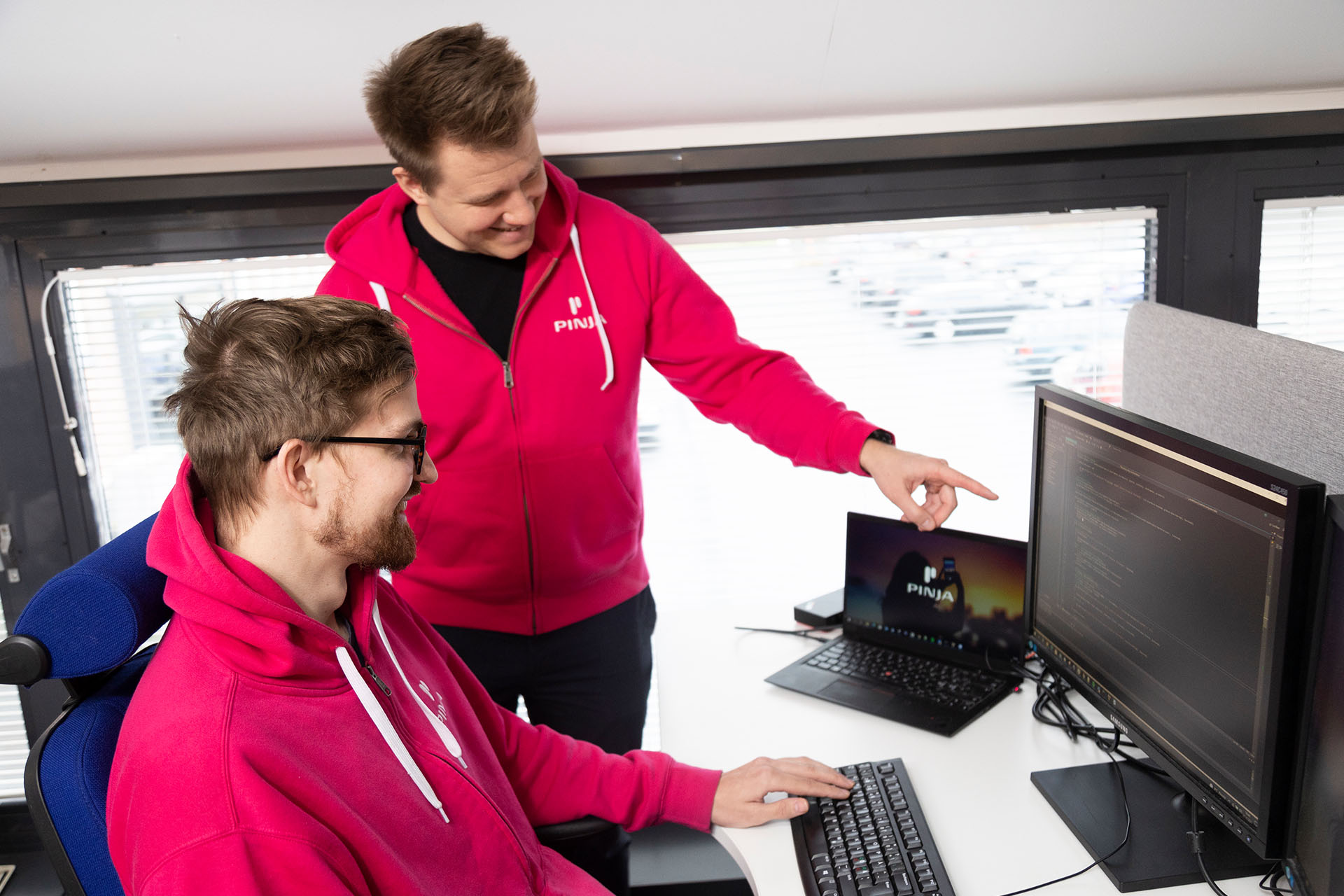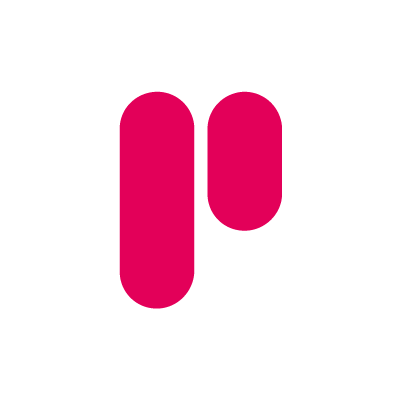
Lauri Haavisto, working on Flow by Pinja, is a software developer who currently works in front end development in his team. The work primarily focuses on what the software looks like to the end user: what the interface looks like, what kind of elements and functionalities it has, and how to make it as clear and easy to use as possible for the end user.
Lauri Haavisto, who lives in Tampere, is one of the many software developers at Pinja. He studied software engineering and software production at university, and started working at Pinja in 2018, at first as a consultant for a client company, then on the supply chain management product Once, and now full-time on the Flow product, which specializes in material flow management and reporting in the circular economy.
- During these years, I mostly worked in development, but in the past, I also worked in tasks related to IT support and databases. I mainly worked on projects as a front-end developer, but occasionally also on the back end, Lauri says.
To put it simply, a front-end developer is a programmer who develops the parts that the user sees of an application on a computer or mobile device. The front-end developer writes code, the end result of which is visible to the user in the service they are using, typically a web page, for example, in the form of desired elements and functionality.
One key thing to remember about working in front end development is that there are often different routes to an end result that looks the same to the end user. To make the code easy to understand for other members of the project and for possible future upgrades, it is worth making it as clear and straightforward as possible from the start. The principles of Lean thinking – cutting out the unnecessary and focusing on the essentials – therefore also apply to software development.

- Of course, each project is different, so starting a new project requires you to get acquainted with it first. With Pinja, I have been able to go through projects with other participants and I have always received good advice. At the moment I mainly work remotely and quite independently, but we keep Google Meet open in the background with my teammates if we have any questions. We also exchange a lot of information via Slack, Lauri says.
→ Career paths of Pinja's employees
→ Check out open positions
A front-end developer makes visible the things that the back-end developer develops under the hood
At Pinja, programmers work as part of teams and also collaborate a lot with each other. Tasks often relate to the further development and updating of an existing service, but, for example, Lauri has been involved in the development of the Flow product almost from the beginning.
A key task for Lauri is, among other things, the event management view in the Flow product, through which the user creates new loads and other events in the system, and monitors and manages their progress. In addition to real-time event management, it is important for client companies that the reports viewed in the system are clear, and that they support the company’s data needs and, thus, also decision-making.

Because front end developers review the development from the user’s point of view, they must always aim for clear and easy-to-use results.
- The product we develop must support different users, browsers and screen sizes. The system is used on computer screens and mobile devices, and must remain functional in all situations. The screen content needs to scale and be responsive. That is why we test the final result on different browsers during the project, and we also have separate testers, Lauri says.
While working in the Once and Flow product teams, Lauri has mainly used Angular technology in his work. Lauri learned the basics of programming and programming languages during his studies, but he feels that he really got to grips with them during the work.
- When I first started working at Pinja, we started by doing things like pair coding. So we coded together with another programmer, with the more experienced coder sitting next to me and giving me advice. We also went through code style and project-specific issues, Lauri recalls.
Nowadays, Lauri’s work is quite independent; he monitors the open tasks on the Jira board and takes them forward according to an agreed prioritization. Other important tools in my daily work include GitHub, the version control system for software development projects, where written code ends up and where it remains clearly managed and accessible to all users. In addition, the Scrumban project management method is used to facilitate visual monitoring of the progress of the work at different stages.
In Lauri’s team, work progress is discussed in 15-minute Daily Meetings, where everyone’s current work situation is assessed, and solutions to potential challenges are found together. An important part of the regular workflow of a front-end developer is also the review of the work done, as, at Pinja, all code passes through at least one pair of eyes before release. There are also regular “retrospect meetings”, where we review the successes and challenges of completed work. This will identify areas for further development and keep us on the path of continuous improvement.
The front-end developer is a problem solver
Lauri Haavisto says that the best thing about his current job is that it gives him the opportunity to constantly solve problems and do something new. The front-end developer is above all a problem solver, because behind every feature that is visible to the user, you have to figure out how to implement it. However, independent work is always supported by a team.
Front end techniques change quickly, so there is always something new to learn. Fortunately, Pinja encourages everyone in their own development.
- I think of myself as more of a technical than a visual person, although I do work that is visible to users. We also have a member in our team who specializes in the user interface side, which is a great help. He designs the foundations for us, on which we build the functionalities.
For Pinja’s future front end developer positions, Lauri encourages people who not only want to solve problems, but also want to learn new things and develop alongside their work to apply.
- Front end techniques change quickly, so there is always something new to learn. Fortunately, Pinja encourages everyone in their own development. I have attended training courses organized by Pinja, and we also get to spend one working day each month studying or doing other personal development, a so-called Lab Day. It’s great, because I like to learn new things, Lauri says.
Overall, Lauri considers Pinja to be a fair and nice employer. He feels that the employer is genuinely interested in the development of its employees and also offers opportunities to challenge oneself. A good thing about Pinja is that you get to work with new technologies.
- It is not hard to start working at Pinja as a new employee. Naturally, you have to learn the house rules, but you get support and good advice from colleagues. I also appreciate the fact that at Pinja, everyone can influence their own work, says Lauri.
Fact box:
💎 A front-end developer creates the visual side of a website or service, and determines, among other things, the locations and functionality of elements. Technologies used by the front-end developer include Angular, React, Vue.js, and Bootstrap. The most common languages include HTML, CSS, Sass, JavaScript and TypeScript.💎 A back-end developer develops what happens behind the finished product that is visible to the end user. Typically, this includes work on databases and logic, for example. The technologies and languages used by the back-end developer include C#, PHP, Python, Java, ASP.NET and Symfony.
💎 A full-stack developer is a combination of the previous two, i.e., a person who does both front-end and back-end software development. A full-stack developer uses both front-end and back-end software development technologies.
Read more:
Pinja enables flexible working models
The “Finnish champion” of web development works at Pinja
Pinja’s training promise is a guarantee of future sustainable services and professionalism
Back to the Pinja Blog
Categories
- Career at Pinja (68)
- Manufacturing (48)
- Knowledge Management (45)
- Production Development (44)
- Software Partnership & Tools (42)
- Sustainability (37)
- Wood and Forestry (37)
- Bioenergy and Recycling (27)
- IT Support and Outsourcing (24)
- Ecommerce (23)
- Maintenance (22)
- Artificial Intelligence and Machine Learning (15)
- Public Services (9)
- Compliance (1)
